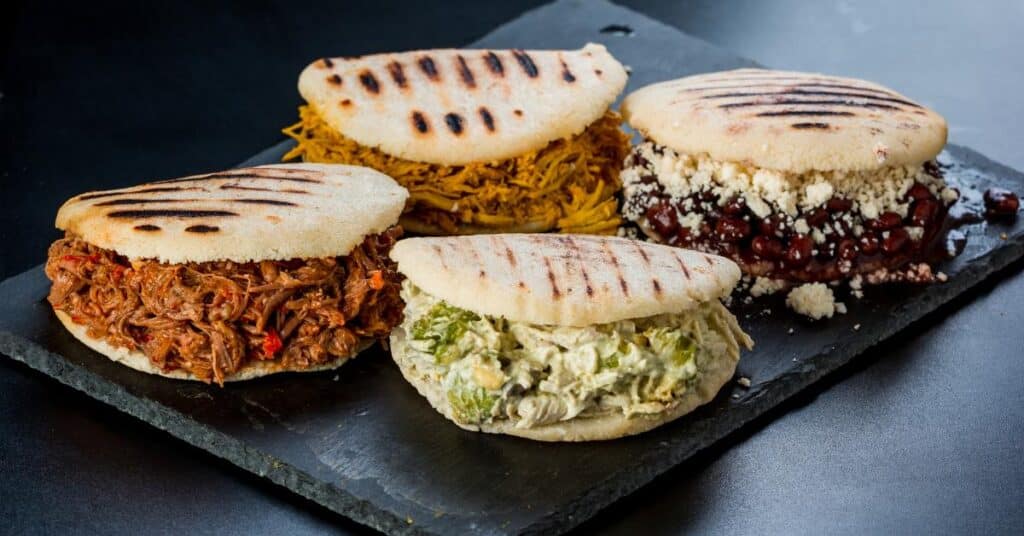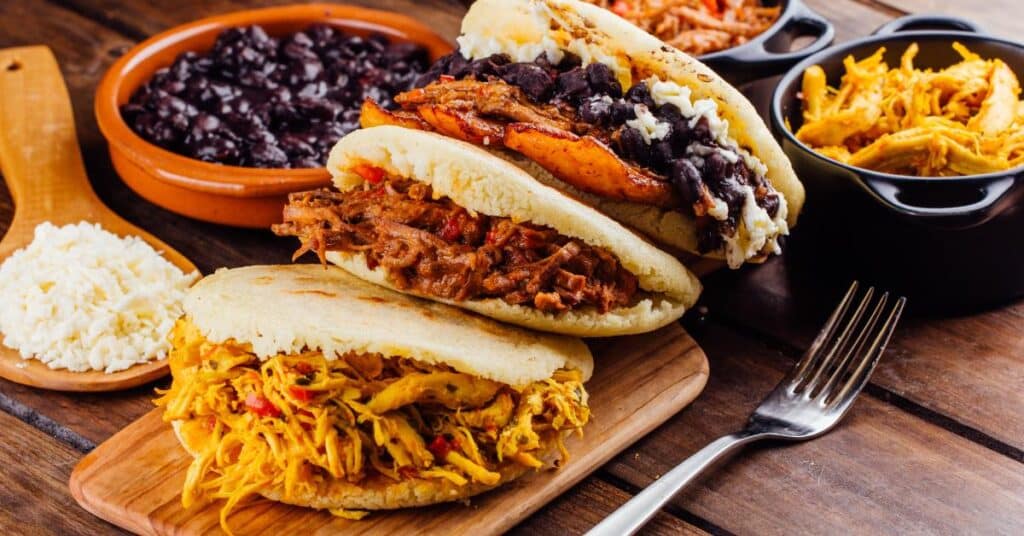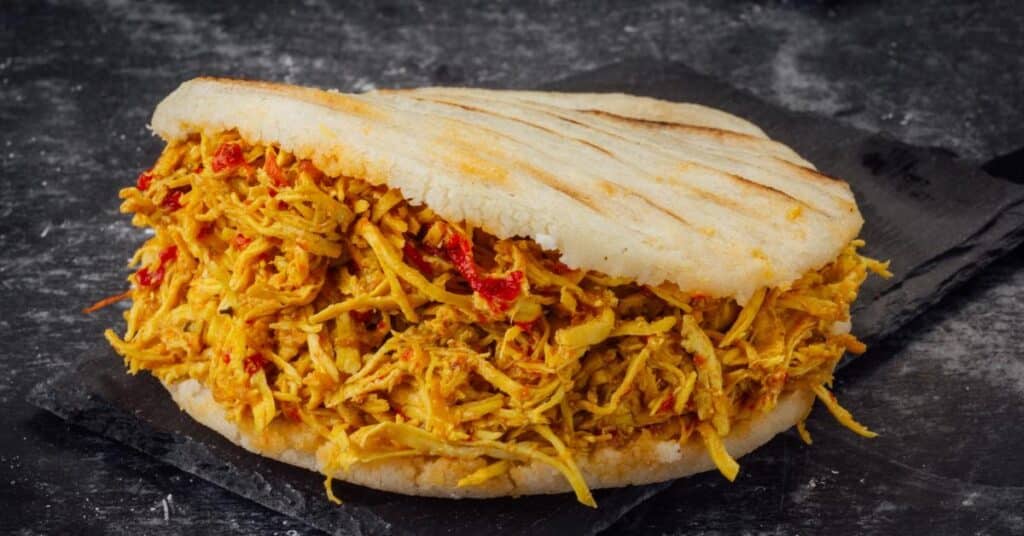
An arepa is a round, flat, dough-like cake made from pre-cooked, ground cornmeal. The dough is typically mixed with a bit of salt and water, then shaped into discs and cooked until golden brown. Arepas can be grilled, baked, or fried, and each cooking method brings out its unique texture and flavor.
The true magic of arepas lies in their ability to be filled with a variety of ingredients. From savory cheese, beans, and shredded meat to sweet jam or fruit, there’s one for every palate.
Arepas Origin
Arepas origins can be traced back to the indigenous people of Colombia and Venezuela, who were making these maize-based delights long before the arrival of European colonizers. As a staple food for the Timoto-Cuica, Muisca, and others, they were prepared differently depending on the region, but the essential ingredients remained the same: maize, water, and salt.
Regional Variations and Names
Arepas have several regional variations, and their names might change depending on the location. Here are some examples:
- Colombian: Often thinner than their Venezuelan counterparts, Colombian arepas are typically served with butter and cheese or filled with ingredients such as eggs, meat, or avocado.
- Venezuelan: Thicker and with a wider variety of fillings, Venezuelan arepas can be found with unique names like Reina Pepiada (chicken and avocado) or Pabellón (shredded meat, black beans, and plantains).
- Dominican: Distinct from the Colombian and Venezuelan varieties, Dominican arepas are sweet, made from cornmeal, and often mixed with sugar, milk, and aniseed, and then deep-fried.
How to Make Arepas

Ingredients:
- Cornmeal: Use pre-cooked cornmeal, also known as masarepa or arepa flour.
- Water: You will combine the cornmeal with warm water to form the dough.
- Salt: Add salt to taste, typically around ½ teaspoon for every cup of cornmeal used.
Instructions:
- In a bowl, mix 2 cups of pre-cooked cornmeal, 2½ cups of warm water, and 1 teaspoon of salt.
- Let the mixture sit for about 5 minutes, allowing the cornmeal to absorb the water.
- Knead the dough until it’s smooth and pliable, adding more water or cornmeal if needed to achieve the right consistency.
- Divide the dough into equal portions and shape them into balls, then flatten them into round discs about ½ inch thick.
How to Cook
- Grill: Preheat your grill to medium heat. Make sure the grates are clean and lightly oiled to prevent sticking. Cook for about 5-7 minutes per side until they have grill marks and become slightly puffed.
- Fry: In a frying pan, heat about ½ inch of oil over medium heat. Once hot, add the arepas (without overcrowding) and fry for 2-3 minutes per side until they’re golden brown and crispy.
- Bake: Preheat your oven to 350°F. Place the arepas on a baking sheet lined with parchment paper and bake for 20-25 minutes or until they’re cooked through and slightly golden.
- Pan-fry: Heat a non-stick or cast-iron skillet over medium heat. Add a small amount of oil or butter, just enough to coat the surface of the pan lightly. Cook the arepas for about 5-7 minutes per side until they’re golden brown and crispy.
Remember to let the arepas cool slightly before serving, as they can be quite hot. Enjoy them with your favorite fillings, such as shredded meats, cheeses, avocado, or beans.
FAQs

What are the ingredients in arepas?
Arepas are made with just a few basic ingredients: pre-cooked white cornmeal (known as masarepa), water, salt, and oil for frying or grilling. You can customize by adding spices, herbs, or cheeses to the dough for extra flavor.
What is the difference between Venezuelan and Colombian arepas?
While both Venezuelan and Colombian arepas have their roots in indigenous culinary traditions, they differ in how they are prepared and served. Venezuelan arepas are usually thicker and filled with a variety of ingredients, while Colombian ones tend to be thinner, often served unfilled and topped with butter or cheese.
What is the difference between a pupusa and an arepa?
A pupusa is a traditional Salvadoran dish made with corn masa, similar to an arepa. However, pupusas are typically stuffed with ingredients, such as beans, cheese, and pork, before being cooked. Arepas, on the other hand, are usually cooked first and then filled with various ingredients.
Can arepas be made with gluten-free ingredients?
Yes, they can easily be made gluten-free since the main ingredient, masarepa, is made from corn and free of gluten. Just make sure to check the label to ensure your pre-cooked cornmeal is certified gluten-free.
What types of fillings can be found in arepas?
The possibilities for fillings are endless! Popular fillings include shredded beef, chicken, or pork, black beans, cheese, avocado, eggs, and even sweet plantains.
How is arepa flour different from regular flour?
Arepa flour, or masarepa, is made from pre-cooked white cornmeal. It is specifically processed for making arepas and has a unique texture and flavor that differs from regular flour. This special cornmeal absorbs water easily, allowing it to form a dough that can be easily shaped and cooked while still remaining soft and moist on the inside. Regular wheat flour cannot be used to make arepas, as it does not share these properties.
